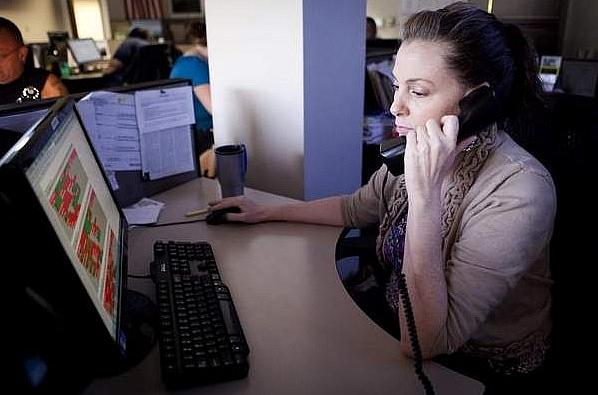How Lines for Life helps out the addicted 24/7
Laura Ungar wrote these stories for The Courier-Journal as a 2012 National Health Journalism Fellow. Other stories in this series include:
Native spirituality helps some cope
Former soccer mom turned addict helping other women
Recovery Kentucky centers use a supportive program in which the clients hold one another accountable
Treatment options for tackling addiction can vary from hours to months
Waiting-list names haunt woman at The Healing Place in Louisville
Funds for infant withdrawal syndrome are scarce
Many more Kentucky babies being born addicted
Addicts overwhelm Kentucky's drug treatment options
Defeated by drugs, Kentucky man takes his own life
Oregon's success in treating addits is a lesson for Kentucky

PORTLAND, ORE. — They call at all hours, desperately reaching out as their addictions spin them into crisis.
Lines for Life, a Portland nonprofit, guides addicts through those dark moments by connecting them with the treatment they need.
The organization has six, 24-hour crisis lines that receive more than 40,000 calls a year. About half are related to substance abuse and the other half to suicide because Lines for Life also provides suicide-crisis intervention. The two often overlap, said Tom Parker, communications director.
Lines are staffed by trained volunteers and master’s degree-level supervisors.
Brittany Baisley, 23, was training to become a volunteer in September. She said she was inspired by her mother, a recovering addict who went through treatment, volunteered at Lines for Life and now is a drug and alcohol counselor.
Baisley said she understands what substance abuse can do to a family; she was raised by a cousin and her husband because her mother couldn’t care for her.
“I feel like there’s so much need in this world, so much brokenness, and we need to give back,” she said.
As part of Baisley’s Lines for Life training, she listened to calls fielded by others. “It’s tough,” she said. “When you hear the calls, it’s heartbreaking, you know? You just want to be there for them.”
Lines for Life connects callers with help when they need it, she said. “There’s so many resources, which is so great.” Treatment “saves lives.”
Volunteers and professionals staffing the phones at Lines for Life have access to an extensive database of treatment and recovery programs throughout Oregon and around the country, ranging from detoxification services to long-term residential programs.
In Kentucky, the anti-drug organization Operation UNITE, in the Appalachian region of the state, operates a referral line that’s narrower in scope. It’s available 8 a.m. to 5 p.m. Monday through Friday, and refers people to treatment in Kentucky and a few out-of-state centers.
It also helps connect eligible callers with a UNITE voucher program that helps low-income addicts in the 5th U.S. House District pay for treatment.
Karen Kelly, president and chief executive officer of Operation UNITE, said 99 percent of calls come from their region because they haven’t promoted the referral line beyond. They haven’t had the money to expand the service beyond business hours.
“We would love to have a round-the-clock hotline, but we only have three treatment staff and the resources just aren’t there,” Kelly said. “If we staffed it 24/7, it would take funding from vouchers, which would mean fewer people would get to go to treatment.”
Lola Patterson, program director at the Knott (County) Drug Abuse Council, said Kentucky needs more treatment-referral services. She said addicts and their family members constantly call her and others, looking for a place to turn.
In Knott County alone, she said, referring people to treatment “could be a full-time job.”
Parker said Lines for Life — which also provides education for youth — could be a model for others. In the year ending June 30, 2011, Lines for Life’s operating expenses were about $2.6 million.
Parker said an agency in a cash-poor state such as Kentucky might be able to provide at least some of the same services for less money — and then reap savings in such areas as foster care and health care.
“The bottom line is you’re going to end up saving a lot of lives,” he said. “And you’re going to save a lot of money.”
This series was first published in the Courier-Journal on December 16, 2012
Photo Credit: Alton Strupp/Courier-Journal

